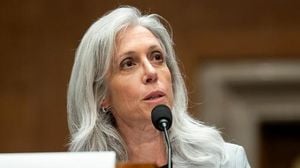CHARLESTON, WV (LOOTPRESS) – West Virginia is grappling with the aftermath of severe flooding, particularly affecting McDowell County. Recent storms have inundated the region, leaving destruction and engagement from local lawmakers, government officials, and citizens striving to provide relief and recovery.
During the floor session on February 21, Delegate David Green (R-McDowell) painted a grim picture of the flooding’s impact. Notably, record-breaking water levels surged three feet above historic levels, devastating communities across McDowell County. “There was no community in McDowell County who did not feel the impact of the flood,” Green stated, announcing the tragic loss of four lives, including those of two grandparents, their two-year-old grandchild, and a firefighter.
According to reports, approximately 75% of McDowell County was without power or water, making travel to the area’s only hospital challenging. Green noted, “Many residents are still stranded with their personal access bridges or roads completely washed away.” Ongoing utility restoration efforts face hurdles, with about 4,000 residents lacking access to public water and 2,000 unable to utilize their wells until they are sanitized.
Despite these stark realities, Green remained optimistic about the community’s resilience. “With each other’s help and support from across this state and nation, we will get through this and come back stronger,” he declared.
The flooding, which struck between February 14 and February 16, showcased West Virginia's vulnerabilities. Areas like Welch were particularly hard hit, where flood waters carried debris, including old tires, onto the streets. The extent of this disaster prompted Governor Patrick Morrisey to make it his first natural calamity to address since taking office just over a month earlier.
Alongside Morrisey, Jim Seward, the new adjutant general of the West Virginia National Guard, has been active on the ground, inspecting the damage and coordinating recovery efforts. “Those efforts are going to continue over the course of the next several days, but this is truly Team West Virginia at its finest,” Morrisey said during a briefing at the Capitol.
The flooding is part of a broader trend, as highlighted by the National Centers of Environmental Information, indicating West Virginia has faced 47 weather and climate disasters with losses exceeding $1 billion since 1980. While the precise cost of the recent floods remains uncertain, they’ve reignited discussions about funding and strategies for mitigation. “We’ve been talking to FEMA,” Morrisey added, expressing hope for swift federal assistance.
Legislative bodies also convened to address recovery and legislative matters, with various bills advancing. Notably, House Bill 2042 aims to provide guardians ad litem with access to court-appointed special advocates (CASA) for children involved in neglect and abuse cases. The House has introduced 794 bills, with the deadline for new proposals approaching on March 18.
All the challenges posed by flooding have once again illuminated the importance of proactive flood mitigation. Past disasters, including the catastrophic flood of June 2016, which saw 23 fatalities, have prompted state lawmakers to focus on resilience measures. After criticism of the RISE West Virginia program, the legislature formed the Joint Legislative Committee on Flooding. Its efforts led to significant structural reforms within state emergency management.
Key legislative measures have emerged, including Senate Bill 677, which allocates funds for disaster recovery and establishes the West Virginia Flood Resiliency Trust Fund to encourage local governments to pursue flood protection projects. Despite these initiatives, challenges persist as the Legislature has yet to appropriate money for the trust fund, which is pivotal for effective flood management.
With the new plans necessitating annual reviews, the State Resiliency Office remains poised to enact strategies guiding future flood response. The office's role is increasingly prioritized, as highlighted by Morrisey’s remarks on the state’s geographic challenges. “We know…when you have heavy rain, when you have 5 inches of rain come in, there’s literally no place for the water to go,” he pointed out, emphasizing the need for substantial mitigation efforts moving forward.
Local community members have shown unwavering spirit as they rally to support those affected. The Mount View High School baseball team, temporarily sidelined from their sport, have taken substantial steps to aid recovery efforts by collecting debris, distributing food, and demonstrating solidarity.
The team member Jacob Waldron stated, “It is truly devastating to see what is going on throughout our county. The damage is just pitiful.” Fellow player Isaiah Noe echoed his sentiments, adding, “I have never seen it in this type of condition.”
Welch’s community spirit is evident through local businesses like the Fortress recreation center, which faced substantial flooding damage but stands unwavering. Owner Shannon Pace noted, “Our building is two stories… the upstairs has all of our main activities and thankfully, it was not touched. But downstairs, we got at least six feet of water.”
Pace candidly shared her financial struggles following the disaster and her determination to rebuild, stating, “I do not intend on reopening the Fortress until May. I do not want to give up on this business. I ask for folks’ prayers, as well as their help.”
West Virginia, with its unique challenges and enduring spirit, remains focused on recovery and building resilience against disasters like this. The collaborative efforts among lawmakers, government officials, and community members might just forge pathways for lasting solutions to the flooding plight. Their narrative continues to be one of hope and mutual support amid adversity.



